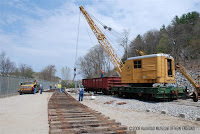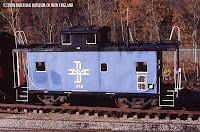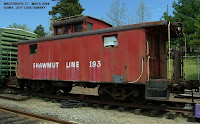
The Long Road Home for New Haven 2059
It was November, 1960. John F. Kennedy had just defeated Richard Nixon in a close Presidential race, becoming the 35th President of the United States. And, in LaGrange, Illinois, the Electro-Motive Division of General Motors had finished building a locomotive for the New Haven Railroad, number 2059, an EMD model FL-9 passenger unit.
NH 2059 closed out the production of the most famous, most recognizable series of diesel locomotives on North American railroads—the 7,690 “F-units” built by EMD. Twenty-one years earlier, demonstrator locomotive GM-103, the first of the Fs, rolled out of EMD’s plant near Chicago, and changed American railroading forever. The 103 and its descendants took on the biggest and the best steam freight and passenger locomotives, and swept them from the rails within fifteen short years.
NH 2059 was a specialized F-unit. The New Haven Railroad needed a diesel locomotive that could also run on electric third-rail power into the Park Avenue Tunnels of Grand Central Terminal in New York. EMD came up with a nine-foot-longer F-9 model, with the extra length providing space for the electric traction equipment. The first FL-9 (“Long F-9”) hit the New Haven’s rails in 1957, and NH 2059 was the sixtieth (and last) of the type.
Operating in passenger service over the New Haven’s compact southern New England system, the FL-9s covered routes out of New York’s Grand Central to Boston, Springfield, Pittsfield, and Cape Cod. They headed up express runs like the ”Yankee Clipper” and “Merchants Limited”, as well as New Haven-New York and Boston-area commuter runs, and branchline locals to Pittsfield, Mass.
After the 1969 takeover of the New Haven by Penn Central, the FL-9s were shifted into New York-area commuter service, eventually becoming Conrail (in 1976) and Metro-North (in 1983) property. Some FL-9s were retired due to fires and lack of proper maintenance during the Penn Central and Conrail years. Six were transferred to Amtrak for Albany-GCT service. Numerous renumberings resulted in NH 2059 becoming PC-CR 5059, and finally Metro-North Commuter Railroad (MNCR) 2033.
By the mid-1980s, Metro-North was planning for the replacement of these twenty-five year old diesel locomotives, even as Metro-North was overhauling and repairing the FL-9 fleet. The need for a dual-mode locomotive was still there, and it was not until 1994 that the first General Electric P-42ACDM “Genesis” locomotives were placed in service by Metro-North. The FL-9 fleet slowly dwindled as the “Genesis” units arrived, with the last few (four to six) FL-9s being used in passenger service on Metro-North in late 2001.
In the summer of 1984, knowing that Metro-North was planning to replace the aging FL-9 fleet, two members of the Railroad Museum of New England decided that NH 2059 should be preserved. Not only the last FL-9, they knew that it was the last F-unit, and therefore a rather historic locomotive. Museum President Bill Sample and Acquisition Manager Howard Pincus met with an acquaintance of Howard’s, MTA board member Jane Butcher of White Plains, NY. They presented the Museum’s proposal for preserving not only NH 2059, but another New Haven diesel, 1947-built 0401, which was on the Long Island Rail Road. Ms. Butcher was favorably impressed with the proposal, and on November 2, 1984, a letter from Metro-North to the Museum indicated that, “..we will make the FL 9 locomotive available to the Museum when possible and this probably will be sometime in 1986.”
The replacement dual-mode locomotives would not be ready for a while--- MNCR 2033 went on to provide eleven more years of service to Metro-North, finally being retired in November 1995. At one point, 2033 narrowly escaped a “rebuilding” into one of the ten ill-fated and highly-modified “starships”—the FL9AC units from Republic Locomotive. The late Richard Gladulich, a Metro-North motive power department employee (as well as a noted railroad historian) was able to have 2033 quietly removed from the list of locomotives slated to become “starships”, and he substituted another FL-9 for 2033.
As 1996 dawned, 2033 sat outside the Harmon (NY) Shops of Metro-North. The Railroad Museum of New England prepared to start operating excursion trains for the public at its new home in Waterbury, Connecticut, on the Naugatuck Railroad.
Follow-up letters and occasional phone calls to get 2033 out of Harmon and to the Museum continued through 1997, 1998 and 1999. Metro-North started using 2033 as a parts source to keep the rest of the FL-9 fleet running, although no critical items were removed. The wheels of bureaucracy turned slowly, but finally, on January 23, 2002, the official documents were signed and Metro-North 2033 belonged to Railroad Museum of New England. Moved to Metro-North’s New Haven Shop in August 2002, 2033 was delivered to RMNE at Waterbury on April 25, 2003. New Haven 2059, Metro-North 2033, was finally home, after almost nineteen years of persistence by the Museum.
NH 2059 is one of the least-modified former MNCR FL-9s, retaining the 24-RL brake system, Vapor OK-4625 steam generator, 16-cylinder 567-D diesel engine, and lacking head-end power connectors and ditch lights. Plans are to restore the unit as NH 2059, keeping as much of the original equipment as possible. It is likely that the locomotive may wear some appropriate “intermediate” paint schemes before the final, full-scale restoration to the 1960 appearance.
The locomotive is currently stored awaiting evaluation for restoration.



























